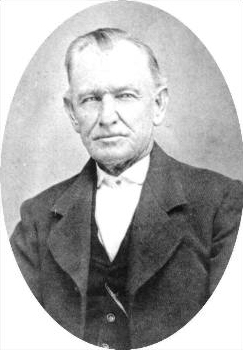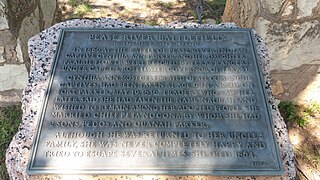Related Research Articles

Henry Eustace McCulloch was a soldier in the Texas Revolution, a Texas Ranger, and a brigadier general in the army of the Confederate States during the American Civil War.

Peta Nocona, also known as Puhtocnocony, or Tah-con-ne-ah-pe-ah, the son of Puhihwikwasu'u, or Iron Jacket, was a chief of the Comanche Quahadi band. He married Cynthia Ann Parker, who had been taken as a captive in a raid and was adopted into the tribe by Tabby-nocca's family. Among their children was Quanah Parker, the last war chief of the Comanche.

The Comanche Wars were a series of armed conflicts fought between Comanche peoples and Spanish, Mexican, and American militaries and civilians in the United States and Mexico from as early as 1706 until at least the mid-1870s. The Comanche were the Native American inhabitants of a large area known as Comancheria, which stretched across much of the southern Great Plains from Colorado and Kansas in the north through Oklahoma, Texas, and eastern New Mexico and into the Mexican state of Chihuahua in the south. For more than 150 years, the Comanche were the dominant native tribe in the region, known as “the Lords of the Southern Plains”, though they also shared parts of Comancheria with the Wichita, Kiowa, and Kiowa Apache and, after 1840, the southern Cheyenne and Arapaho.

The Red River War was a military campaign launched by the United States Army in 1874 to displace the Comanche, Kiowa, Southern Cheyenne, and Arapaho tribes from the Southern Plains, and forcibly relocate the tribes to reservations in Indian Territory. The war had several army columns crisscross the Texas Panhandle in an effort to locate, harass, and capture nomadic Native American bands. Most of the engagements were small skirmishes with few casualties on either side. The war wound down over the last few months of 1874, as fewer and fewer Indian bands had the strength and supplies to remain in the field. Though the last significantly sized group did not surrender until mid-1875, the war marked the end of free-roaming Indian populations on the southern Great Plains.
Buffalo Hump was a War Chief of the Penateka band of the Comanches. He came to prominence after the Council House Fight when he led the Comanches on the Great Raid of 1840.

Henry Wax Karnes was notable as a soldier and figure of the Texas Revolution, as well as the commander of General Sam Houston's "Spy Squad" at the Battle of San Jacinto.
Moses Lapham was a soldier in the Texas Army during the Texas Revolution, noted for a daring action during the Battle of San Jacinto that helped seal the decisive Texian victory.
The Battle of Plum Creek was a clash between allied Tonkawa, militia, and Rangers of the Republic of Texas and a huge Comanche war party under Chief Buffalo Hump, which took place near Lockhart, Texas, on August 12, 1840, following the Great Raid of 1840 as the Comanche war party returned to west Texas.

The Great Raid of 1840 was the largest raid ever mounted by Native Americans on white cities in what is now the United States. It followed the Council House Fight, in which Republic of Texas officials attempted to capture and take prisoner 33 Comanche chiefs and their wives, who had earlier promised to deliver 13 white captives they had kidnapped. Because of the poor amount this Penateka band of Southern Comanche received for the ransom of nine year old James Putnam weeks before, they only brought a 16-year-old Matilda Lockhart. Just as they had done to the Mexican's and Santa Fe'ans for nearly a century, the Penaketa wanted to ensure they'd received a higher payment before ransoming the other whites they had abducted. This tactic, together with the terrible treatement they had wrought on Miss Lockhart backfired and the Indians found themselves taken hostage for a prisoner exchange. An attempt to escape, followed by the brandishing of knives, tomahawks the Comanche had secreted between their wives' blankets led to the massacre of all the male Indians except two elderly men, who along with the women were taken hostage.

The Council House Fight, often referred to as the Council House Massacre, was a fight between soldiers and officials of the Republic of Texas and a delegation of Comanche chiefs during a peace conference in San Antonio on March 19, 1840. About 35 Comanche men and women under chief, Mukwooru represented just fraction of the Penateka band of the southern portion of the Comanche tribe. He knew he had no authority to speak for the Southern tribes as a whole and thus, any discussions of peace would be simply a farce. However, if Mukwooru could re-establish a lucrative trade with the San Antonian's perhaps a peace, by proxy, could be established. Just as the Comanche had done had been done for centuries in San Antonio, Santa Fe and along the Rio Grande. They would rob one settlement and sell to the other.

The Battle of Pease River, also known as the Pease River Massacre or the Pease River fight, occurred on December 19, 1860, near the present-day town of Margaret, Texas in Foard County, Texas, United States. The town is located between Crowell and Vernon within sight of the Medicine Mounds just outside present-day Quanah, Texas.

The Battle of Little Robe Creek, also known as the Battle of Antelope Hills and the Battle of the South Canadian, took place on May 12, 1858. It was a series of three distinct encounters that took place on a single day, between the Comanches, with Texas Rangers, militia, and allied Tonkawas attacking them. It was undertaken against the laws of the United States at the time, which strictly forbade such an incursion into the Indian Territories of Oklahoma, and marked a significant escalation of the Indian Wars. It also marked the first time American or Texas Ranger forces had penetrated the Comancheria as far as the Wichita Mountains and Canadian River, and it marked a decisive defeat for the Comanches.
The Texas–Indian wars were a series of conflicts between settlers in Texas and the Southern Plains Indians during the 19th-century. Conflict between the Plains Indians and the Spanish began before other European and Anglo-American settlers were encouraged—first by Spain and then by the newly Independent Mexican government—to colonize Texas in order to provide a protective-settlement buffer in Texas between the Plains Indians and the rest of Mexico. As a consequence, conflict between Anglo-American settlers and Plains Indians occurred during the Texas colonial period as part of Mexico. The conflicts continued after Texas secured its independence from Mexico in 1836 and did not end until 30 years after Texas became a state of the United States, when in 1875 the last free band of Plains Indians, the Comanches led by Quahadi warrior Quanah Parker, surrendered and moved to the Fort Sill reservation in Oklahoma.
The Battle of the Neches, the main engagement of the Cherokee War of 1838–1839, took place on 15–16 July in 1839 in what is now the Redland community. It resulted from the Córdova Rebellion and Texas President Mirabeau Bonaparte Lamar's determination to remove the Cherokee people from Texas. Many Cherokee had migrated there from the American Southeast to avoid being forced to Indian Territory.
The Battle of North Fork or the Battle of the North Fork of the Red River occurred on September 28, 1872, near McClellan Creek in Gray County, Texas, United States. A monument on that spot marks the site of the battle between the Comanche Indians under Kai-Wotche and Mow-way and a detachment of cavalry and scouts under U.S. Army Colonel Ranald S. Mackenzie. There was an accusation that the battle was really an attempt "to make a massacre," as during the height of battle some noncombatants were wounded while mixed in with warriors.
The Córdova Rebellion, in 1838, was an uprising instigated in and around Nacogdoches, Texas. Alcalde Vicente Córdova and other leaders supported the Texas Revolution as long as it espoused a return to the Constitution of 1824.

Matthew Caldwell,, also spelled Mathew Caldwell was a 19th-century Texas settler, military figure, Captain of the Gonzales – Seguin Rangers and a signer of the Texas Declaration of Independence. Because of his recruitment ride ahead of the Battle of Gonzales, some call him the Paul Revere of Texas.
James Milford Day was a 19th-century Texas military figure. He was a member of Mathew Caldwell's and Jack Hay's Seguin Rangers and a participant in the Mexican–American War.
Robert Addison Gillespie (1815–1846) was a business man, land speculator, and Captain in the Texas Rangers under John Coffee Hays and Zachary Taylor. Gillespie died in the Battle of Monterrey. Gillespie County, Texas, was named in his honor.
Yellow Wolf, Spirit Talker 's nephew and Buffalo Hump 's cousin and best support, was a War Chief of the Penateka division of the Comanche Indians. He came to prominence after the Council House Fight, when Buffalo Hump called the Comanches and, along with Yellow Wolf and Santa Anna, led them in the Great Raid of 1840.
References
- ↑ "The Comanches must tire of hostilies". Telegraph and Texas Register. September 1, 1838. Page 2, column 5, second paragraph below "Hon. David G. Benton".
- ↑ Thomas W. Cutrer, "KARNES, HENRY WAX," Handbook of Texas Online , accessed October 08, 2011. Published by the Texas State Historical Association.
- ↑ Brown, John Henry. Indian wars and pioneers of Texas. The Internet Archive. Austin: L.E. Daniel. p. 50.
- ↑ Moore, Jr., Francis, ed. (September 1, 1838). "The Comanches must become tired of hostilities". Telegraph and Texas Register. Page 2, column 5, second paragraph after "Hon. David G. Burnet".
- ↑ Moore, Stephen L. (2006). Savage frontier. vol. II, 1838-1839 : rangers, riflemen, and Indian wars in Texas. Denton, Texas: University of North Texas Press. p. 19. ISBN 1-57441-206-X.